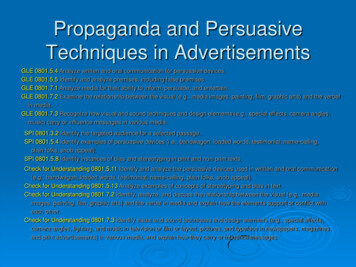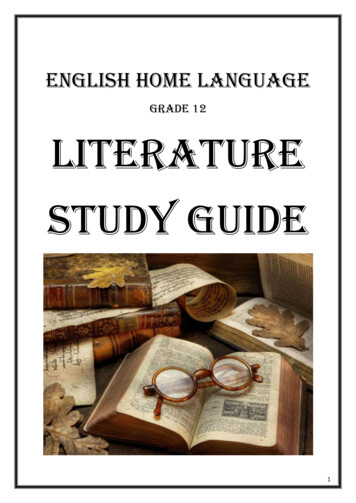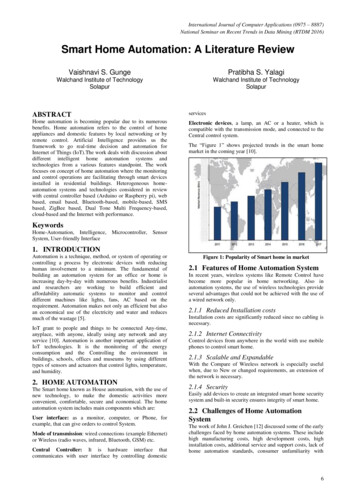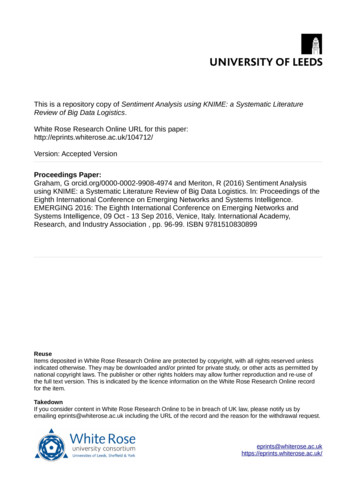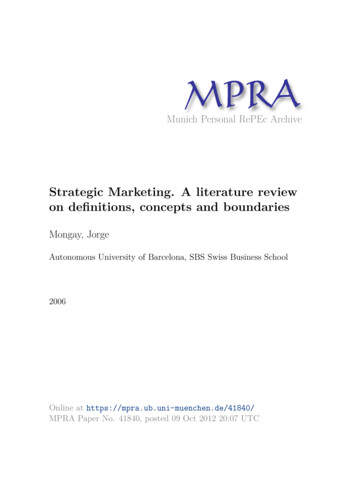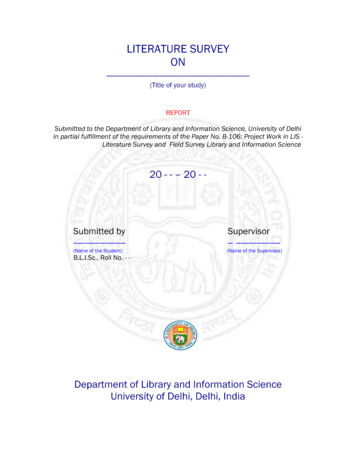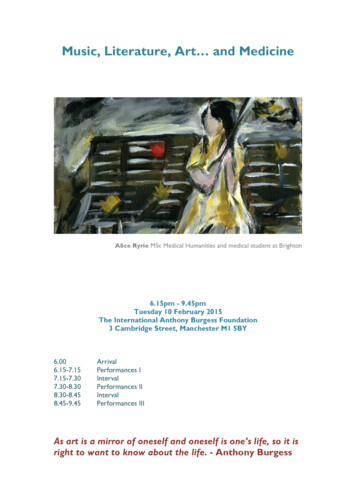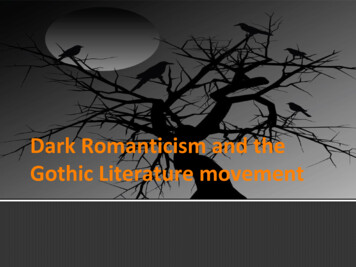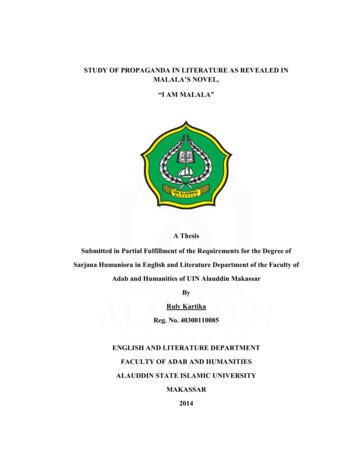
Transcription
STUDY OF PROPAGANDA IN LITERATURE AS REVEALED INMALALA’S NOVEL,“I AM MALALA”A ThesisSubmitted in Partial Fulfillment of the Requirements for the Degree ofSarjana Humaniora in English and Literature Department of the Faculty ofAdab and Humanities of UIN Alauddin MakassarByRuly KartikaReg. No. 40300110085ENGLISH AND LITERATURE DEPARTMENTFACULTY OF ADAB AND HUMANITIESALAUDDIN STATE ISLAMIC UNIVERSITYMAKASSAR2014
I would present this thesis for people who loves me
MOTTOWhen you want something all the universe conspires inhelping you to achieve it(Paulo Coelho)You don’t always need a plan, sometimes you just need tobreathe, trust, let go, and see what happens(writer)ii
PERNYATAAN KEASLIAN SKRIPSIDengan penuh kesadaran, penulis yang bertanda tangan dibawah ini,menyatakan bahwa skripsi ini benar adalah hasil karya penulis sendiri, dan jikadikemudian hari terbukti ia merupakan duplikat, tiruan, plagiat, atau dibuat olehorang lain secara keseluruhan ataupun sebagian, maka skripsi ini dengan dan gelaryang diperolah batal demi hukum.Makassar, 7 Desember 2014PenulisRuly Kartika40300110085iii
ACKNOWLEDGMENTThe writer would like to thank God for His blessing and guidance in theprocess of doing the research. The writer very grateful for the precious lessons shegot through completing the thesis. The writer realizes that the thesis could not bedone without any favors given to me by many individuals and institutions,particularly those with the deep care, love, and support. In this memorable moment,the writer would like to express her deepest gratitude to the very adorable.1. Her beloved Mama, Daria and Bapak, Rustam for love, care, support,and pray they deliver every single time.2. Her beloved aunt, Kartia. Thanks for your unconditionally love.3. Her beloved ones, om Mulyadi Kasim (alm), tante Hj. Haniba, Fachryand Annisa for their love and affection.4. The rector of UIN Alauddin Makassar, Prof. Dr. Qadir Gassing, HT.MS., and his staff for their approval and administrative support.5. The dean of Adab and Humanities Faculty, Prof. Dr. Mardan, M. Ag.,and his staff, the Head and Secretary of English and LiteratureDepartment, Dr. Abd. Muin, M. Hum, and Serliah Nur, S. Pd. M.vii
Hum., M.Ed., for their support, approval, and permission to write thethesis.6. Her first and second supervisor, Dr. Abd. Muin, M. Hum. and SardianMaharani Asnur. S. Pd, M. Pd for his and her guidance, advices,encouragement during the writing of the thesis.7. She would like to thank to the lecturers who have contributed andtransferred their knowledge to the writer during the academic years,Syahruni Junaid S.S., M. Pd, Nasrum Marjuni S. Pd,. M. A. and thosewho cannot be mentioned one by one.8. Her special thanks to Mr. Adriansah for his great motivation.9. Her incredible nephews and cousin, Tegar, Tyzar and Ulfha for all theircuteness.10. Her special thanks is addressed to Muh. Ismail Hasbi that always gaveme spirit and helped me during my study and writing this thesis.11. Her dearest friends, Cha, Vivi, Nunu, Eki, and Anti for all theirmotivations and encouragements.12. Her close friends in Senior High School, Bulkis, Maya, Rara, Vivi,Chya’, Kiki, Ika, Novi, Amelh, and Dinda. Thanks for your supportguys.13. All her friends at Pondok Salemba, Rara, Arma, Rani, and Celly for theirsupport and motivation.viii
14. All her friends in class of 2010 English and Literature Department UINAlauddin Makassar, AG.1, AG. 2, AG. 3, and AG, 4 for your years oftogetherness we passed in the university. Love you guys.15. All individuals and institutions having contribution during the thesismaking process that the writer cannot mention one by one, thanks for thesupport.After all the writer has tried to do her best in writing of the thesis, but thewriter realizes that this thesis is far from being perfect.The writerix
TABLE OF CONTENSTITLE PAGE .iMOTTO .iiPERNYATAAN KEASLIAN SKRIPSI .iiiPERSETUJUAN PEMBIMBING .ivPENGESAHAN SKRIPSI .vAPPROVAL SHEET .viACKNOWLEDGMENTS .viiTABLE OF CONTENTS .ixABSTRACT .xiCHAPTER I INTRODUCTIONA. Background.1B. Problem Statement .3C. Objective of Research .3D. Significance of Research .3E.4Scope of Study .CHAPTER II REVIEW OF RELATED LITERATUREA. Previous Findings .x5
B. Intrinsic Element.6C. Communication Theory .8D. Rhetoric .9E.Propaganda Theory .10F.The Impact of Propaganda .17G. Social Background in Pakistan .17H. Synopsis of The Novel .19I.20Biography of Malala Yousafzai .CHAPTER III METHODOLOGY OF THE RESEARCHA. Research Method .22B. Source of Data .22C. Instrument of the Research .22D. Procedures of Data Collection .23E.23Technique of Analyzing Data .CHAPTER IV FINDINGS AND DISCUSSIONSA. Findings .24B. Discussions .31CHAPTER V CONCLUSIONS AND SUGGESTIONSA. Conclusions .37B. Suggestions .39xi
BIBLIOGRAPHY .41BIOGRAPHY .43xii
ABSTRACTNameReg. NumberTittleSupervisor ISupervisor II: Ruly Kartika: 40300110085: Study of Propaganda in Literature as Revealedin Malala’s Novel “I Am Malala”: Abd. Muin: Sardian Maharani AsnurThis thesis studied about the analysis of propaganda in literature as revealedin Malala’s novel “I Am Malala”. The aim of this thesis is to analyze and to describethe propaganda of the Taliban who will do anything to gain power in Pakistan. Thestrongest effort they are doing is spreading propaganda to the entire community in theregion.The theory of propaganda, Jacques Ellul, is used to find out the ways Talibanuse propaganda as their strategy and to find out the kinds and purpose of propagandathey use. The method of this research is qualitative method concerned with thedescription and explanation of propaganda phenomenon. Sociology of literatureapproach is used to connect the social issue occurred in the novel and the socialcondition of Pakistan the time the novel was published.In this thesis, the writer found three kinds of propaganda as strategy of theTaliban to carry out their actions in the novel; the first is integration propagandawhich is propaganda that use religion as a bridge, because religion is the doctrine ofthe strongest for all believers. The second is the horizontal propaganda which is donethrough the directly individual approach. The third is vertical propaganda that usesmass media as the main tool for influencing the public.Those are the three kinds of propaganda used by Taliban to gain power and togive a doctrine to Pakistan society. Meanwhile, the writer also found the purpose ofpropaganda used by Taliban that wants to change the actions and expectations of theindividual target. The Taliban show how hard they carrying out their propaganda andhow hard a girl who called Malala also strongly opposed to the propaganda of them.The conclusion of this thesis is the writer gives explanation about the kinds ofpropaganda were created by the author to clarify the conflict that had occurredxiii
between The Taliban and the society. Then the writer gives the purpose of thatpropaganda. This thesis implicates how propaganda has become the socialphenomenon in life and implicitly forms the perspective in looking at thesurroundings.xiv
CHAPTER IINTRODUCTIONA. BackgroundLiterary work is an author’s creative thinking. The author writes the literarywork based on what he feels, sees, and experiences in real life. It is a reflection ofreal life. Although the form is fiction, such as short story, novel, and drama, theissues presented by the author cannot be separated from everyday real lifeexperiences. Therefore literary works can be a potrait of life through the characters,plot, and setting of the story (Aristotle in Davis, 2002:3).Abrams (1981:61) defines novel as a fiction that introduces an imaginationword that consists of intrinsic elements like setting, plot, characteristics, point ofview, etc. In line with Abrams, novel is created in the middle of society as animaginative work of its author and as a reflection based on the social structure. It is apart of literature which is essentially a social institution that loudly speaks theauthor’s point of view about what is happening in the world.A novel often presents adocumentary picture of life.Furthermore, a novel is sometimes used by an authority or a group to conveythe doctrine to others as well as the propaganda used by the people in their society toconvey a doctrine to others. According to Gramsci (1971:367), propaganda is a poweror domination over life values, norms, and cultural group of people who eventually1
2turns into a doctrine of the other communities where the group is dominated byconsciously followed.Meanwhile, according to Ellul (1965:62), propaganda refers to the managementand the control of people’s behaviours, and beliefs. It is a medium to set and plantparticular ideas in to the community to gain approval for the ruling group.Based on the definition, the writer concludes that propaganda isaway toinfluence others to follow our will which uses words or sentences. Throughpropaganda, a person can change the mindset of someone about something.The writer is, therefore, interested in analyzing propaganda in novel “I AmMalala” by Malala Youzafsai and Christina Lamb. This novel tells about the girl whostood up for education and was shot by the Taliban. When the Taliban took control ofthe Swat Valley in Pakistan, Malala spoke out. She refused to be silenced and foughtfor her right to an education. On Tuesday, October 9, 2012 when she was fifteen, shealmost paid the ultimate price. She was shot in the head at point-blank range whileriding the bus home from school, and few expected her to survive.Malala was shotwith the intention killed by the Taliban, because she is a girl who dared to challengethe Taliban forbade girls school. No matter she is just a teenage girl who was only 16years old. When the Taliban under the leadership of Maulana Fazlullah, whocontrolled Swat banned all girls school.It makes the writer interested in analyzing thestudy of propaganda by applyingEllul’s theory of propaganda.
3B. Problem StatementBased on the above information, the writer focuses on research questions asfollows:1. What are the kinds of propaganda used in “I Am Malala”?2. What are the impacts conveyed through the propaganda in the novel “I AmMalala”?C. Objective of ResearchThe objectives of the study can be stated as follows:1.To find out the kinds of propaganda in the novel “I Am Malala” by MalalaYousafzai and Christina Lamb.2.To describe the impacts which are conveyed through thepropaganda foundin the novel“I Am Malala” by Malala Yousafzai and Christina Lamb.D. Significance of ResearchThe significances of the study are as follows:1.This study will be a reference to the next researchers who are interested instudying about propaganda.2.To give any information about sociology especially in social interaction,which is related to how a person make a doctrine and others can followhis/her.
4E. Scope of StudyIn analyzing the thesis, the writer focuses on investigating the kinds ofpropagandathat used by The Taliban in “I Am Malala” novel and identifying thepurpose conveyed through the propaganda based on Ellul’s theory and will supportby O’Donnels’s theory. In the novel “I Am Malala.”there area number kinds ofpropagandathat the writer will analyze,which are the integration of propaganda(which is done through religion), horizontal propaganda (which is doneindividuallyand/or directly), and vertical propaganda (which is done through mediamassa).
CHAPTER IIREVIEW OF RELATED LITERATUREA. Previous FindingsThe writer presents some previous findings, which are related or relevant withthis research, as follows:Zulkifli (2011) in his thesis, "Power of Conspiracy in the Novel by Dan BrownDeception Point". Heanalyzedthe roles of language and mass media in the formationof conspiracy in the novel “Dan Brown” and the messages found in the novelregarding to conspiracy in the novel.He found that the mass media had an importantinfluence in a conspiracy and propaganda by a group of people to change an existingsystem of government.Achdar (2011) in his thesis,"Power in the Novel Thank You for Smoking byChristopher Buckley (Sociological of Literary Approach)”. He found thattheinfluences of Academy of Tobacco Studies in the social environment in the novel of“Thank You for Smoking” by Christopher Buckley. He found thatthe power oflanguage, rhetoric and the mass media could become a propaganda tool for thecommunity. He mentioned that the public could easily be affected by the greatness ofa person in a play that developed issues coupled with his ability in giving suggestionsto others.Syam (2012) in his thesis, “Propaganda Expression in Angel and Demon Novelby Dan Brown”. He found that the expressions of propaganda in the novel “Angeland Demon” by Dan Brown wanted to change the mindset of people towards their5
6views to the brotherhood of the Illuminati. The novel attempts to explain the historyof the birth of a conflict between the Christian and the Illuminati.Besides, this thesisdemonstrated four kinds of propaganda by the theory of Ellul.The similarity of the previous findings and this research is to explain aboutpropaganda theory. However,Zulkifli focused on the power of mass media as a tool ofpropaganda theory on the novel by Dan Brown “Deception Point”. Achdar focused onthe power of language, rhetoric, mass media and propaganda to affect the people tobe a consumer of cigarettes on the novel by Christopher Buckley “Thank You forSmoking”. Taufik focused on the propaganda expressions to change the mindset ofpeople towards their views to the brotherhood of the Illuminati.Meanwhile, in this research, the writer focuses on the types of propaganda aswell as the messages regarding to woman education in muslim country (Pakistan) inthe novel “I Am Malala.”B. Intrinsic ElementIntrinsic elements of a novel are critical components that must be present toestablish a novel. The following are some of the intrinsic elements that exist in anovel, according to Flaherty (2010: 25-32).1. ThemeTheme is the main idea underlying a literary work. Simply put, the theme issomething on which a story is based, something that animates the story, orsomething that is the main problem in the story.
72. CharacterCharacter is an individual creation by the author who experiences events ofthe story, or something that is the main problem in the story.3. PlotPlot is the order or sequence of events in the story.4. SettingBackground is any information, instruction, reference relating to time,space, atmosphere, and the situation of occurence of events in the story.Background can be divided into three main elements: the place, time, andatmosphere.5. Point of ViewThe view pointis a way of looking at the author in putting himself/herselfin a certain position in the novel.6. Style of LanguageStyle of language –processing techniques by the author in an effort toproduce a lively and stylistic literary work. This should be supported by thedictions (choice of words).7. MessagesMessage is the moral teachings to be conveyed by the author through hisnovel. Just like a theme, the message can be conveyed implicit by way ofproviding moral teachings or messages in a behavior or events that occur in the
8character before the story ends. It can also be delivered explicitly warnings,advice, suggestions, or prohibitions related to the main idea of the story.C. Communication TheoryCommunication is the process of delivering thoughts or feelings by one personto another by using signs that are meaningful to both parties. In certain situations,communication uses certain media to change the attitude or behavior of someone orsome people to achieve certain goals (Miller, 2005: 13).One of the theoreticians of mass communication as well as the most famous isHarold Lasswell. He puts forward a model of communication which is simple andoften quoted by a lot of people. The model consists of five elements (Muth, 2004:117-120) as follows:1. Who? (source)Communicators are the main actors/parties who have a need tocommunicate or initiate a communication. It can be an individual, group,organization, or a country.2. Says what? (message)Message refers to what will be delivered/communicated to the recipient(communicant) from the source (communicator) or information content. It is asymbol of a set of verbal/non-verbal that represent feelings, values,ideas/intention of the source. There are three components of the message that isthe intention of the source. There are three components of the message that is
9the meaning, symbols to convey meaning, and from/organization of themessage.3. In which channel? (channel/media)Tool/medium conveys the message of the communicator (source) tocommunicant (receiver) directly (face to face), or directly (throughprinted/electronic media).4. To whom?Receiver is the person / group / organization / the country that receives themessage from the source.5. With what effect? (impact/effect)Impact/effect occurs to the communicant (receiver) after receiving amessage from a source, such as a change in attitude, increasing knowledge, etc.D. RhetoricRhetoric as art to speak has a relationship with the communication process.Communication in this context is a process of delivering information from thecommunicator to the communicant, so that communicants understand what isintended and what is desired by the communicator. In rhetoric, the communicationprocess is very important. A retort must be able to communicate the content of themessage properly and effectively to public. Thus, a retort must understandcommunication patterns used in delivering the content of the message, and thosecommunication patterns can be known from the type of audience who will belistening. This is important to achieve effective communication (Gardina, 2005:113).
10Language factor is equally important, if the two parties will understand eachother when using the same language. Thus, the rhetoric would not be separated fromthe process of communication, and it can be said that communication is absolutely apart of the rhetoric.E. Propaganda TheoryPropaganda gives a way such as planting of information and ideas to influenceand emphasize certain attitudes and behaviors. Of course this can not be done in ashort time, because it requires the process until there is acceptance of the concept isembedded through conditioning and habituation to the desired thing. In thepropaganda, we don’t know right or wrong, who emphasized that the content ofpropaganda is how it believed by someone and in turn encourage the person to act inaccordance with the objectives of a propaganda.The next is to deliver something with changing something that has a goodcredibility so that the target received it without knowing it. According to Gramci(1971: 400) propaganda is used as a process of mastering the dominant class to lowerclass and lower class are also actively supporting the ideas of the dominant class.Here the control is done not by force, but through consent forms dominated society.While, Lasswell (1971:627) says that propaganda is the management of collectiveattitudes by the manipulation of significant symbols. Propaganda is used as a way toin still trust in the community to be able to follow all the wishes of the ruling group.According to Morley (2002:44), propaganda is a form of persuasivecommunication that succeeds in states where the are totalitarian governments and
11cannot exist in a true democracy. Coxall states that propaganda is defined as thedissemination of information which is favorable to the objectives of the manipulatorbut which omits information which is unfavorable. The information distributed inpropaganda is normally accurate as far as it goes, but the reports issued by amanipulator are incomplete, and whatever facts considered contrary to themanipulator’s interests are filtered out before transmission to the victim.Malesevie (2010:203), states that propaganda is a strenuous reproduction form oforganized communication involving production, reproduction and dissemination ofideas, images and messages that are aimed at persuading and influencing the opinionsand actions of large groups of individuals. Smith in Marlin (2013: 9), propaganda isthe more or less systematic effort to manipulate other people’s beliefs, attitudes, oractions by means of symbols (words, gestures, banners, monuments, music, clothing,insignia, hairstyles, designs on coins and postage stamps, and so forth). A relativelyheavy emphasis on deliberateness and manipulation distinguishes propaganda fromcasual conversation or the free and easy exchange of ideas.Propaganda is the deliberate and systematic attempt to shape perceptions,manipulate the minds, and direct behavior to get the desired reaction disseminators ofpropaganda. (O'Donnell, 2005:50).Propaganda sometimes conveys the actual message, but the content is oftenmisleading in which it generally only conveys facts that can produce a certain effect,or more emotional reactions than rational reaction. The goal is to change the mind of
12the cognitive narrative of the subject in the target audience for a particular interest(72).Therefore, propaganda is a deliberate and systematic attempt to shapeperceptions, manipulate the mind or cognition, and directly affect the behavior toprovide the desired response of the propagandist. Whether the propaganda is acceptedor rejected by the people given by the propagandist.As a one to many communication, propaganda separates the communicator fromthe communicant. However, according to Ellul, a communicator in propaganda isactually a representative of an organization that seeks controlling toward thecommunicant group. It can be concluded that a communicator in propaganda is anexpert in social control. With a wide range of technical skills, each ruler of thecountry or those who aspire to become the ruler of the country must use propagandaas a means of social control mechanisms (Nelson, 2006: 25)Leonard W. Dobb (1963: 40) states that the propaganda efforts made byindividuals who are concerned to control the attitude of the group, including by wayof using the suggestion, resulting into the control of the activities of the group.Spread lies repeatedly shown to the public. The repeated lies, will make thepublic being believe (Goebbles, 1998, ropagandaascommunication "used by an organized group that wants to create active or passiveparticipation in the actions of a mob psychologically made up of individuals andunited in an organization. According to him, propaganda is closely related to the
13organization and action, which is practically non-existent without the propaganda.Hedivides propaganda into four types:1. Propagandaof AgitationIn the case of agitprop, the ideas to be disseminated were those ofcommunism, including explanations of the policy of the Communist Party andthe Soviet state. In other contexts, propaganda could mean dissemination of anykind of beneficial knowledge, e.g., of new methods in agriculture. Agitationmeant urging people to do what Soviet leaders expected them to do; again, atvarious levels. In other words, propaganda was supposed to act on the mind,while agitation acted on emotions, although both usually went together, thusgiving rise to the cliché "propaganda and agitation".Propaganda of agitation is a movement to gain sympathy, acceptance ofideas, and the spread of desires, demands that can influence the masses toparticipate in the movement, in the organization or make changes.Propaganda agitation attempts to arouse the attention or encourage othersto conduct a systematic plan or joint movement for the dissemination of a beliefor doctrine.Propaganda agitation focuses on the actual issues that are trying to pushan action againts the issue. Propaganda deals with the explanation of ideasdetailed and more systematic. Therefore, it is clear that the agitation andpropaganda are two closely related matters.
14A real example of an agitation propaganda is political advertising isstructured activities undertaken by the candidate ( Politicians ) to influence theaudience, in the form of incitement, propagandize the public, to obtain politicalobjectives (S.P.Huntington, 2000: 40).Agitation begins with making the contradictions in society and moveaudiences to oppose the reality of life experienced during this (full ofuncertainty and suffering) with the intention of causing anxiety among themasses.Moreover, propaganda of agitation is usually performed by a person orgroup engaged in politic. They use this propaganda to attract the sympathy ofthe public. This agitation propaganda tends seditious, therefore this kind ofpropaganda is also commonly called a provocation.2. Propaganda of IntegrationPropaganda of integration is a type of propaganda which is done byinstilling confidence to others based on the belief or knowledge they alreadyhave before. In general, this type of propaganda used religion as a bridge,because religion is the doctrine of the strongest for all believers.Propaganda of integration mobilizes in pursuit of conformity in the longperiod. Through the propaganda, the people devoted themselves to the goalsthat may not be realized in many years, even during their lives. It means that thepropagandists itself is not convinced whether propaganda they would giveacceptable or not by society.
15Propaganda integration, moreover, is more subtle forms than the agitationwhich aims to strengthen cultural norms. It is sociological in nature as itprovides stability to the community by supporting a way of life and myth in theculture. This is a propaganda of conformity that requires participation in thesocial body. This type of propaganda is more prominent and permanent, but it isnot recognized as an agitation propaganda because propaganda of integration ismore permanent. Basically, agitation propaganda provides motive power whenneeded and when not needed propaganda of integration provides context andbackground.As a conclusion, this propaganda of integration is the type of propagandathat uses religion as a means of communication. To convey this propaganda, thepropagandist did not use violence but expressed in a subtle way.This propaganda is to unite the long period that people serve this purpose,but usually objectives set forth in this propaganda will never materialize.3. Horizontal PropagandaHorizontal propaganda is a kind of propaganda which is done through thedirectly individual approach. Such propaganda is generally the most effective.It is mostly done in the membership of the group compared to the group leader.In other words, horizontal propaganda works among the membership ofthe group rather than the leader of the group; more often through interpersonalcommunication and orgazational communication rather than trough masscommunication. Traditionally political parties rely on propaganda horizontally,
16such as a visit to the local organization committee, training of party cadres,conspiracy in prisons, and so on. Moreover, more through interpersonalcommunication and organizational communication are more effective than massco
1. To find out the kinds of propaganda in the novel “I Am Malala” by Malala Yousafzai and Christina Lamb. 2. To describe the impacts which are conveyed through thepropaganda found in the novel“I Am Malala” by Malala Yousafzai and Christina Lamb. D. Significance of R
